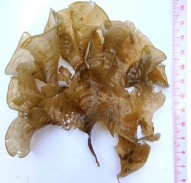Bioactive Extracts from Padina boryana Thivy from Phu Quoc Island, Vietnam: In vitro Antioxidant, Anticancer, Alpha-glucosidase inhibitory, Anti-inflammatory, Antimicrobial, and Hepatoprotective Activities
Main Article Content
Abstract
The brown alga Padina boryana Thivy has been studied for its bioactive properties. This study aimed to evaluate the antioxidant, anticancer, alpha-glucosidase inhibitory, anti-inflammatory, antimicrobial, and hepatoprotective activities of Padina boryana extracts. The antioxidant activity was investigated using DPPH and ABTS radical scavenging, and ferric reducing power assays. The anticancer activity was determined via cytotoxic activity on human lung carcinoma (A549) and human embryonic kidney (HEK 293) cancer cell lines. Alpha-glucosidase inhibitory activity was determined using standard method, anti-inflammatory activity was assessed via nitric oxide (NO) inhibition assay, antimicrobial activity was assessed using the broth microdilution assay, and the hepatoprotective activity was evaluated using CCl4-induced hepatotoxicity in HepG2 cells. Results showed that the algal extracts have low DPPH scavenging activity, but effective ABTS scavenging activity with EC50 value of 52.09 µg/mL for the ethyl acetate (EA) extract. The EA extract had the highest ferric-reducing power with EC50 of 61.7 µg/mL. The petroleum ether (PE) extract had the highest cytotoxic effect with EC50 values of 38.19 µg/mL and 33.28 µg/mL against A549, and HEK 293 cells, respectively. All extracts showed significant alpha-glucosidase inhibitory activity, with EA being the most potent (IC50 = 3.01 µg/mL). The PE extract showed notable NO inhibitory activity with IC50 of 50.91 µg/mL. No significant antimicrobial activity was observed except for EtOH and PE extracts, which inhibited Staphylococcus aureus and Bacillus subtilis. The extracts did not demonstrate significant hepatoprotective effect. These findings highlight the potential of Padina boryana as a valuable source of natural therapeutic agents.
Downloads
Article Details

This work is licensed under a Creative Commons Attribution-NonCommercial-NoDerivatives 4.0 International License.
How to Cite
References
Ahmed N, Sheikh MA, Ubaid M, Chauhan P, Kumar K, Choudhary, S. Comprehensive exploration of marine algae diversity, bioactive compounds, health benefits, regulatory issues, and food and drug applications. Measurement: Food. 2024: 100163.
Thomas NV and Kim SK. Beneficial effects of marine algal compounds in cosmeceuticals. Mar Drugs. 2013; 11(1):146-164.
Sameeh MY, Mohamed AA, Elazzazy AM. Polyphenolic contents and antimicrobial activity of different extracts of Padina boryana Thivy and Enteromorpha sp marine algae. J Appl Pharm Sci. 2016; 6(9):087-092.
Sonbol H, Ameen F, AlYahya S, Almansob A, Alwakeel S. Padina boryana mediated green synthesis of crystalline palladium nanoparticles as potential nanodrug against multidrug resistant bacteria and cancer cells. Scientific reports. 2021; 11(1):5444.
Rushdi MI, Abdel-Rahman IA, Saber H, Attia EZ, Madkour, HA, Abdelmohsen UR. A review on the pharmacological potential of the genus Padina. South Afr J Bot. 2021; 141: 37-48.
Al-Enazi NM, Awaad AS, Zain ME, Alqasoumi SI. Antimicrobial, antioxidant and anticancer activities of Laurencia catarinensis, Laurencia majuscula and Padina pavonica extracts. Saudi Pharm J. 2018; 26(1):44-52.
Chander MP, Veeraragavam S, Vijayachari P. Antimicrobial and hemolytic activity of seaweed Padina gymnospora from South Andaman, Andaman and Nicobar Islands of India. Int J Curr Microbiol Appl Sci, 2014; 3(6):364-369.
Silva GC, Soares RC, Carvalho FCT, dos Santos Rocha R, dos Fernandes Vieira RHS, de Sousa OV. Antibacterial and cytotoxicity activity in macroalgae extracts: perspectives for the use against pathogenic bacteria from shrimp farms (Litopenaeus vannamei). Acta Sci Biol Sci. 2018; 40:1-9.
Kalasariya HS, Pereira L, Patel NB. Comprehensive phytochemical analysis and bioactivity evaluation of Padina boergesenii: unveiling its prospects as a promising cosmetic component. Mar Drugs. 2023; 21(7):385.
Ajibola CF, Eleyinmi AF, Aluko RE. Kinetics of the inhibition of renin and angiotensin I am converting enzyme by polar and non-polar polyphenolic extracts of Vernonia amygdalina and Gongronema latifolium leaves. Plant Foods Hum Nutr. 2011; 66:320–327.
Cam TT, Quoc NC, Vi PV, Quang LD, Tuan ND, Phien HH, MenTT, De TQ. Morphology of Vernonia amygdalina L. and Study of ItsAntioxidant Property, α-Amylase and α-Glucosidase Inhibitory Activity, Hepatoprotective Potency and Toxicity. Trop J Nat Prod Res. 2024; 8(5):7128-7133.
Tuan N, Thi H, My C, Hai T, Tran-Trung H, Nguyen T. Inhibition of α-Glucosidase, Acetylcholinesterase, and Nitric Oxide Production by Phytochemicals Isolated from Millettia speciosa—In Vitro and Molecular Docking Studies. Plants. 2022; 30; 11:388.
Marques RV, Sestito SE, Bourgaud F, Miguel S, Cailotto F, Reboul P, Moulin D. Anti-inflammatory activity of bryophytes extracts in LPS-stimulated RAW264.7 murine macrophages. Molecules. 2022; 27(6):1940.
Jain NK and Singhai AK. Ameliorative effects of Spinacia oleracea L. Seeds on carbon tetrachloride (CCL4)-induce hepatotoxicity: In vitro and in vivo studies. Asian Pac J Trop Biomed. 2015;2(1):153-158


